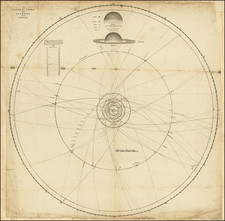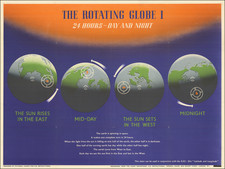Rare separately published double hemisphere celestial map, published in Amsterdam by Frederick De Wit.
The stars are heighten in gold.
An exceptionally decorative, oversized, very rare celestial chart, produced by Frederik de Wit illustrating the two hemispheres surrounded by six supplementary models, illustrating the Copernican hypothesis, the Ptolemaic hypothesis, the Tycho Brahe hypothesis, the phases of the moon relative to the Sun, the rotational pattern of the day, and the rotation pattern of the Moon around the Earth.
Each major hemisphere is centered on the elliptic pole and rendered on a polar stereographic projection with an external orientation. The constellations are drawn and colored to emphasize the signs of the Zodiac and other famous constellations.
De Wit's illustration of the constellations is clearly derived from the celestial hemispheres appearing as supplementary material on Joan Blaeu's 1658 wall map of the world (Shirley 371).
This is the first of two states. The later state bears the imprint of Covens & Mortier.
Rarity
OCLC locates 3 institutional examples of the map.
De Wit (1629 ca.-1706) was a mapmaker and mapseller who was born in Gouda but who worked and died in Amsterdam. He moved to the city in 1648, where he opened a printing operation under the name of The Three Crabs; later, he changed the name of his shop to The White Chart. From the 1660s onward, he published atlases with a variety of maps; he is best known for these atlases and his Dutch town maps. After Frederik’s death in 1706, his wife Maria ran the shop for four years before selling it. Their son, Franciscus, was a stockfish merchant and had no interest in the map shop. At the auction to liquidate the de Wit stock, most of the plates went to Pieter Mortier, whose firm eventually became Covens & Mortier, one of the biggest cartography houses of the eighteenth century.












![[Auriga]](https://storage.googleapis.com/raremaps/img/small/83182.jpg)

![[ Phases of the Moon ] Phasis Lunae Adultae, observata Viennae Anno MDCXCVI Die 6 Nove intra 5 et 6 p [and] Phasis Lunae ad Oppositionem vergentis, observata Segedini Anno MDCXVI die 12 Iulii, hor 10 pomer.](https://storage.googleapis.com/raremaps/img/small/95539.jpg)

![[Piscis Austrinus] (Stars Heightened in Gold)](https://storage.googleapis.com/raremaps/img/small/83184.jpg)